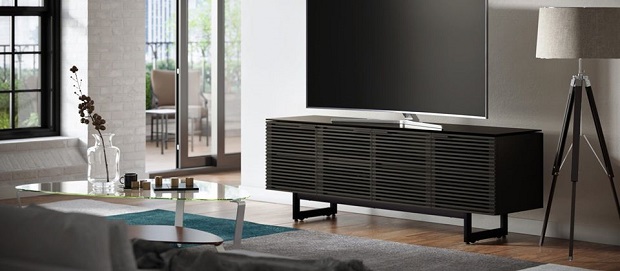Dave Adams is Vice President of Marketing for BDI, a leading designer and manufacturer of quality home entertainment, office, shelving and modular furniture. BDI’s collections combine original design with innovative function to seamlessly integrate technology into the home and office environments. Here is our recent interview with Dave:

Q: Who is BDI, and why are you passionate about the way we live with technology?
A: We’re a design team committed to creating beautiful, functional furniture that complements the way people live. Our furniture collections include home entertainment furniture, office solutions, modular storage systems and more.
We’re endlessly fascinated by the principles of modern design and how they can be applied to contemporary work culture and living spaces. That means keeping an eye on how ever-evolving technologies shape our everyday lives. Technology affects how we interact with our surroundings, and so it’s vital our surroundings are built to facilitate seamless ease of use.
To that end, we believe design can make our lives simpler, richer, better organized and more efficient. Our furniture is engineered with a host of user-friendly features that do just that. Smart design can improve the quality of everyday life. In our connected world, it’s increasingly important that our surroundings support our interactions with technology. Smart design helps us perform our best in work and in life.
Q: How is the office furniture that we use today different than it was 20 years ago?
A: Twenty years ago, office equipment was enormous, and there was a lot of it. Think about those bulky tower-and-monitor combos from the ‘90s. Many of us also had big desk phones and possibly a separate answering machine. We used a lot of paper, so we needed not only printers, copiers and scanners but also filing cabinets and shredders. And, of course, there was the fax machine.
Today, the majority of working Americans get by with a laptop or tablet. The smartphone has replaced the desk phone/answering machine combo. Printers today are smaller and can perform scanning and saving functions as well, and we certainly aren’t storing paper files like we used to with the advent of online and cloud storage.
Naturally, as our tech needs have become more streamlined, so has our office furniture. We can get by with a much smaller footprint — which is great news for people who work from home offices and for companies setting up open workspaces. In either of these situations, the trend is for people to plug their laptop into the workstation and leave when they’re done. To that end, desks need to be durable enough to support a large stationary monitor as well as a laptop and wireless keyboard/mouse combo.
But even with less equipment, there is still a lot of wiring that needs to be planned for, even if it’s just chargers for wireless technology. The better office systems have smart wire management built into the design to accommodate for cords, keeping the desktop surfaces uncluttered and focused.
Aesthetics are still very important; especially in executive spaces where desks, shelving and consoles need to work together in a cohesively elegant yet efficient system. The days of the heavy metal file cabinets are gone, replaced by coordinated furniture that can be equally at home in corporate or home settings alike.
 Recommended: An Interview With Kirsten Bay, CEO & Co-Founder At Cysurance
Recommended: An Interview With Kirsten Bay, CEO & Co-Founder At Cysurance
Q: How have technological innovations affected the office experience?
A: Thanks to portable technology, telecommunications and remote work has really taken off. You can sit down and call into that conference from virtually anywhere. It’s not that offices are becoming obsolete. Rather, the concept of the “office” has become more flexible to include a greater variety of spaces.
And thanks to cloud storage and teamwork software, we’re far less reliant on paper. Again, this means we don’t have to dedicate the same resources to storage, organization and disposal.
An increased interest in ergonomics and healthy work/life balance has led to a boom in products and services. Today we have wearables that ping you to stand up and walk around every hour or even encourage better posture, or our chairs can be personalized to a sit that is most comfortable for us. Personally, I’m a big fan of the adjustable-height desk, which allows me to work at comfortable sitting or standing positions with just the press of a button throughout the workday.
Of course, technology isn’t without its own special requirements, and it’s important for office furniture to include features like wire management systems, ventilation for equipment, durable anti-glare surfaces and easy organization on desktops.
Q: How has the growth in home offices and collaborative spaces influenced what is needed from office furniture?
A: People are working from home more than ever. According to a ABCCGallup survey, 43% of Americans work from home at least part of the time. Regardless of whether these workers are staying home once a week or every day, it’s important that they create dedicated spaces — the living room sofa just won’t do! — that keep all their necessities within easy reach. It’s also important that the furniture they choose for these spaces complements the overall aesthetic of the rest of their home.
In collaborative spaces, versatility is the name of the game. Desks need to have enough surface area to allow multiple colleagues to pull up a chair and work from any side. Durability is especially important in these settings. We also like smart features like standing desks that can be programmed to include several users’ preferred working heights, which is especially useful in co-workspaces, or even in home offices where both people telework.
Q: So, what is important to look for when you are considering office furniture.
A: First and foremost, you need to think about how you’ll be interacting with the space. For example, a graphic designer might need a computer desk as well as a larger table for drawing. An attorney, therapist or consultant will need additional space for locking sensitive documents as well as a comfortable sitting area for meeting with clients.
From there, it’s important to look for pieces that will best support your equipment and your work style. Would you do better with a sit-to-stand desk? Will you be working collaboratively with a colleague? Are you working with a full double-screen/desk phone/smart speaker setup, or are you just looking for a place to sit down with your laptop?
Either way, ergonomics always matters. One of your most important investments will be an ergonomic desk chair. Your back will thank you.
And then it’s time to think about the aesthetic you’re trying to achieve. Wood pieces are going to give a more traditional feel. Materials like steel and glass give a more modern look, and a combo of both lends to a transitional vibe. Whatever you choose, a professional office needs to look consistent, so you’ll want to make sure these design elements are there in your desks, chairs, cabinets and shelving.
A useful guide can be found here on the BDI website.
 Recommended: Soluno Delivers Phone Systems That Works With All Units Across All Carriers
Recommended: Soluno Delivers Phone Systems That Works With All Units Across All Carriers
Q: How do you see design changing in the coming years as technology continues to advance?
A: Life moves fast, and it’s only going to get faster. We receive and process information, perform everyday tasks, receive packages and travel faster than ever. Technology, of course, is the big driver behind this expediency, and design must adapt to its ever-changing needs.
We predict USB charging/wireless mini routers will become de rigueur in desktop design and there will be an increased interest in adjustable-height desks. But as cloud-based storage becomes more prevalent, we’ll need fewer storage drawers. In short, the work desk will evolve to support digital technology.
And as urban living and small living becomes more prevalent, there will be an increased demand for multi-purpose furniture. Think small wall-mounted surfaces that can do double — or triple — duty as a bill-paying station, a laptop desk and even a place to have a quick bite to eat, and consoles that can store equipment while also serving as an elegant credenza.
As a company, BDI stays abreast of the latest technology and lifestyle trends to stay at the forefront of what’s new. Keeping an ever-watchful eye on these trends allows us to incorporate these advances thoughtfully into the next generation of designs.

